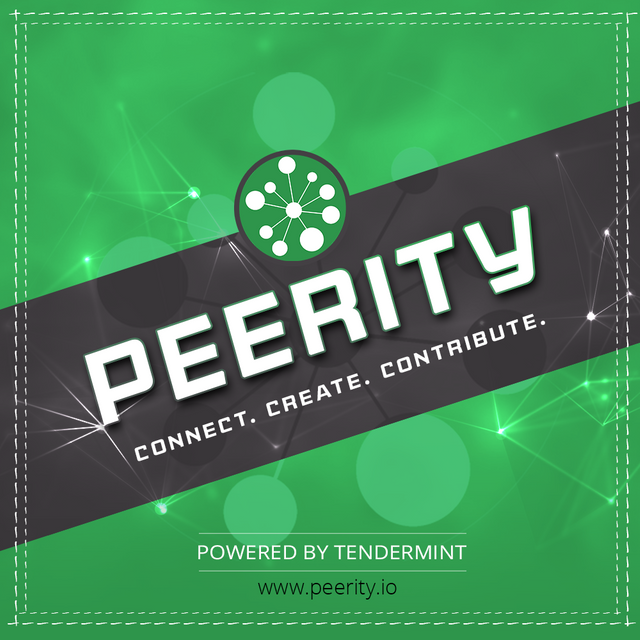Decentralization to the Rescue: Peerity – Steem’s Competitor?
Previously published
VICE – The Porn Token
The Sun Exchange - Solar Microgrids in Africa
Brave – Encrypted Internet Browser
Sphere – Social Media that Tokenizes Your Personal Data
Ignite – Decentralized Rating System
Hybrid social media entering the scene

Peerity is very similar to Steem really. I have first spotted the project like five months ago, when I was settling on Steemit and was searching for other ways how to get rewarded for contribution in the form of written text. I found a Steemit like platform that aims to support online AND offline activities of HIGH QUALITY alike. I was confused – naturally. How do they want to measure offline activities and how do they want to make sure that only activities of high quality get to be rewarded. Whitepaper should contain the answers right? So I’ve read it and now I’m going to present its summary as a part of my newly born series. I will try to be as objective as the subjective myself can handle. I will also not pretend that I understand the technicalities of their Tedermint system and I recommend all the geeks to read it for yourself. Let’s get started!
Communities

As most of the Steemians know, communities (in form of SMT) are being born on our platform. We are very much looking forward to it, but in all honesty, we don’t really have a clue how exactly will it work. Well Peerity will have its communities implemented right from the start and with a very clear-cut concept in mind. Unlike Steem (which is from my humble point of view one of its BIGGEST weakness), Peerity will have no mishmash of all the “posts” only categorized by its tags. In our environment this leads to totally unprocessable amount of data.
Peerity will fix this issue by hierarchical model of the communities. At the start, Peerity will have “system-created communities” (I imagine that as for example philosophy, events, services, etc.) which will serve as starting feeds. Users though have the ability to create sub-systems under those communities in order to further specify the interests and enable the users to search for them easily. The sub-systems can then be almost anything, from location-based services, to sub-categories of certain philosophical movements.
Personal data

Not long ago I presented Sphere as an aspiring social media that will give us back the control over our personal data. Now, in all honesty, I’m pretty sure that Peerity totally crushes Sphere, because they too aim to leave the control over our personal data in our hands, but that is hardly the limit of the platform. Not only will Peerity serve as a social media with a built-in messenger (beating Steem too in that regard), but it will also provide the users with a user-friendly interface that will alert us about community activities in our vicinity, posts, or availability of products of our liking. Overall the user-friendliness (on paper) seems to be the best of all the mention platforms. Paper is not reality, but potential is definitely there!
The Peerity token

An unfixed amount of Peerity tokens will be minted (the range is supposed to be around 0,5 – 1,5 Peer tokens per second). The amount will be “equal” to the activity that is being generated on the platform. Those of you that remember early Steemit days, there were pay-outs raging around 1000 dollars mark (when the price was 20 cents!). That was due to the fact that there was almost no traffic, and the reward pool was getting bigger and bigger (not the only reason, but one of them). Peerity aims to fix this. They do not want to have a horrendous supply of the token, if it doesn’t meet the demand. That might be bad for those like me that have already decided that they want to try the platform out prior its beta phase, but it probably is a good thing for the platform itself. It also has a negative (from my point of view – according to the whitepaper it’s a good thing). Minting tokens according to the activity (more or less the indicator of the demand) means that there will be limited upward spikes in price. That is shame for all the holders, because those spikes are the time when investors wants to realize gains, before buying back in.

Here you can see the actual distribution of the minted tokens
Activity rewards

60% of all the tokens will then be distributed among ordinary contributors like myself.
And now the interesting part. How will the “quality of posts” be measured? Whereas on Steemit the “judging” has been in the hands of all the stakeholders, Peerity aims to change that…partly. If I understood it correctly, in the user-created sub-communities, the pay-outs will be decided in a very similar way like on Steemit. The whitepaper is rather unclear about that – there is still room for improvement.
Online content
On the other hand the whitepaper is clear about all the factors that will be taken into account when rewarding any given “activity” of the main categories. First aspect, that is well known to us, Steemians, is the reputation. There, as well as here, the reputation doesn’t have a direct effect on the rewards, but it does increase the potential of traffic on our accounts. And traffic is the first direct influencer of the reward. Easily put, the more views and TIME SPENT on the content, the bigger reward. But that is of course not it. Another influencer is an amount of “engagement” on the post. In other words quality comments generated on any given activity.
The whitepaper still uses the term “quality” and it finally explains the term in later stages of the document. The creators aim to do a hybrid measuring of quality – semi-human, semi-AI curation. That means that the content will be partly curated by users, and partly by machine learning systems.
Just like on Steemit, rewards can be also “flagged” (flagging, or down voting (whatever suits you better) is an extremely important feature. The hybrid system mentioned above will try to punish trolls, or any offensive acts. It will also search for and punish copy pasta posts.
Offline activities
I understand the whole curation of offline activities as rather experimental. Here are some of the first ideas how to measure it.
- Users could be validating their visitation of the contest via GPS.
- Organizers could be providing special code through which the reward could be redeemed.
- If the users pay for the event through Peerity, the system can measure the “value of the event” and reward the contributors accordingly.
- If the users use Peerity, even the sales from the event can be measured and contributors could then be also rewarded accordingly (long live the Blockchain).
Summary

It’s hard to compare Peerity and Steemit further more. Steemit has been in beta for almost two years, whereas Peerity doesn’t have a working product so far. The main differences seem to be …
Peerity
- protects personal data
- rewards online and offline activity alike
- half human, half AI curation
- communities implemented and will function in a predictable way
- better categorization of the content (probably only before SMT launches)
- built-in messenger
Steem
- has advantage of two beta testing years (history of “bugs” solved)
- stakeholders can influence the rewards more
- seems like Steem has bigger potential rewards
- spikes in price (easier to realize gains, while keeping the same amount of tokens after the rebuy)
Both tokens are supporting content creation, both have smart contracts implemented (after SMT), have fast transaction, use POS, algorithm changes in the hands of witnesses (for Peerity in later stages)…I for one think that Peerity will be a healthy competition. Both systems could be learning from each other’s mistakes and concentrate on slightly different approach of content rewarding. Nuff said. I’m investing. ICO starts tomorrow.

Can we invest using some of our steem? If so, how?
Sure. They will open the ICO 2morrow. They have also proclaimed that they will support big variety of cryptos with which to participate. Steem will prolly not be one of them but you can always sell your Steem or SBD (I recommend bittrex.com) for the accepted token. To visit their page use the link provided at the beginning of the article.
Yeah the only issue Is that bittrex is not allowing new accounts since December which is when I arrived in steemit haha
So I haven’t got the chance to create my bittrex account yet.
binance then?